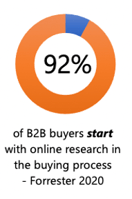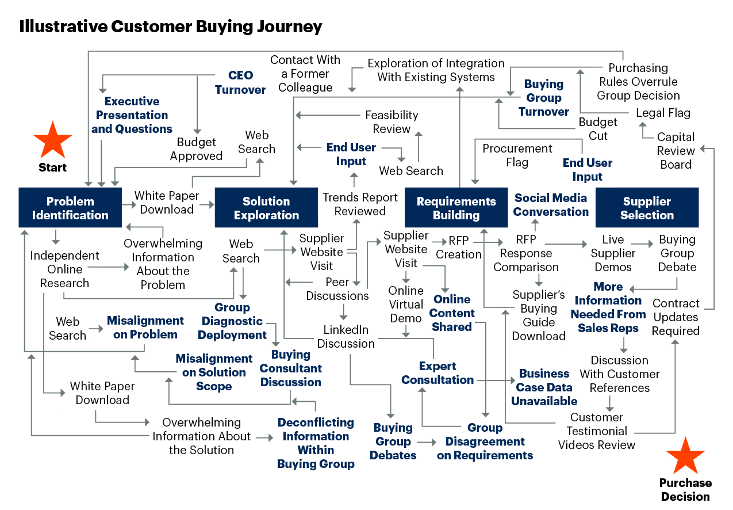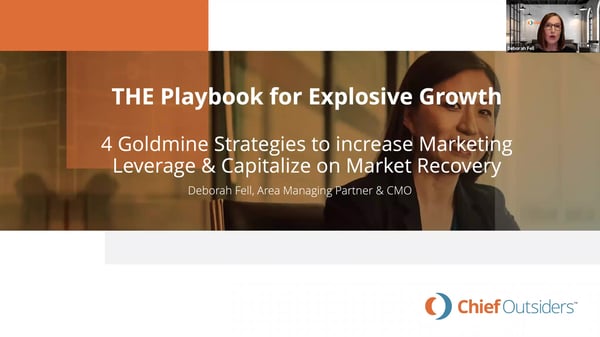Marketing with Impact: Four Goldmine Strategies

Of all the ways to make money, panning for gold is probably among the most difficult. But what if I were to give you all the panning equipment and a map indicating exactly where the gilded stash is buried? A little easier now, right?
Today, I’m here to deliver the precious metals – a goldmine of marketing strategies that, if followed, may not result in gilded nuggets, but instead more customers, more revenue, and a golden future.
First, let’s recognize the obvious – your B2B customer is also looking to uncover some gold. But in their search for a product or service that’s going to fill a very specific need, they won’t be spending a lot of time on the phone or pounding the pavement.
 According to a recent Forrester study, 92 percent of B2B buyers start with online research in the buying process and spend the largest single chunk of their time (27 percent according to a recent Gartner study) in this activity. As a result, these buyers are nearly 60 percent through their decision before they ever speak with a company’s sales representative. According to FocusVision, B2B buyers consume 13 pieces of content on average primarily from the vendor’s website, internet searches and social media. These buyers likely know as much or more about your company and the competition as you do!
According to a recent Forrester study, 92 percent of B2B buyers start with online research in the buying process and spend the largest single chunk of their time (27 percent according to a recent Gartner study) in this activity. As a result, these buyers are nearly 60 percent through their decision before they ever speak with a company’s sales representative. According to FocusVision, B2B buyers consume 13 pieces of content on average primarily from the vendor’s website, internet searches and social media. These buyers likely know as much or more about your company and the competition as you do!
The attached graphic illustrates just how circuitous the route is for today’s customer, from idea to purchase, and the paths they are likely to travel:
 Source: Gartner 2021
Source: Gartner 2021
With virtually all buyers starting their research online, you would be wise to start there, too; however, how you start, and what you do, matters. Otherwise, those valuable buyer eyeballs will shift to another firm that is more adept at creating a connection.
At the outset, I promised you a goldmine – though your results may vary, here are four keys I’ve employed successfully with my B2B clients to help them define their online marketing strategies, and to make them count:
- Discover your target customer and his/her buying process:
Have you spent time getting to know your customer segment – I mean, really understanding what makes them tick? What’s the core problem driving the search for solution, and how do they look for solutions and develop requirements? If your discovery only asks about their need for your product, that won’t work because the gold is much further below the surface. With a firm understanding of not only needs and challenges, but the related pain, fear and uncertainty, you can develop an effective strategic and targeted approach to support their research and buying process, and demonstrate that you are the one that “gets” them. Without this, marketing is a shot in the dark at best, and your message will be undifferentiated.
If you also have insight into your target customer’s buying process, broader context of their problem and depth of concern, you can create effective, relevant messaging in the right channels and move the needle in your direction.
Remember this parable: Homeowners are not searching for a hammer when they go to the hardware store -- they are looking for something to help secure the nail that hangs the picture and takes the room from an uncomfortable place to a thing of beauty. If you’re selling hammers, it’s your job to understand the problem from the customer’s perspective, and then demonstrate to them throughout their buying journey that you have the superior solution to solve it. Same is true with B2B customers.
- Create and execute a clear value proposition.
It’s tempting for people to overlook or overthink this step, thinking there’s no need to re-look or getting lost in the word-smithing. At this stage, we should be focusing on the essentials of the value proposition and putting it into words – answering these questions:
- What problems do you solve?
- Who do you solve them for?
- How do you uniquely solve them?
- What are the functional and emotional benefits?
- Why should prospects choose you over any other solution?
Easy, right? But knowing this, and articulating it, are two distinct tasks. Assuming you have the right offering at the right price and are accessible in the right channels, converting this value proposition into brand positioning and messaging will be key to differentiation in your market.
Every aspect of the business, including channel decisions (where to distribute/sell), product/service lines (what to sell) and pricing (what do distributors or consumers pay) are part of the equation. For example, where a company distributes says a lot about the brand. If you distribute in discount channels, you may get some traction fast to start up or to make up for a tough quarter; however, you will become the discount brand. So, communicating what kind of company you are on each of these dimensions is an essential ingredient.
Again, be thorough in your message development and thoughtful in how and where you place it. Often, marketing agencies or consultants will facilitate a workshop to conduct a word exercise and call it a value proposition. That’s not enough. Your value is what your customers perceive it to be, so think through your offering, and what messaging needs to be where.
“Your value is what your customers perceive it to be”
- Create a go-to-market plan.
This is where you will create the roadmap to nurture the right type of customer for your revenue-sourcing aspirations. To do this right, and I will insist again, ad hoc marketing has simply got to go. Random tactics will not convey the right message. Messaging in the wrong channel will miss the mark. And the right channel with the wrong message means you are wasting time and money and demonstrating to prospects that you are not the right choice.
This is where digital will take an outsized role: It is critical to have not just an online presence, but an effective online presence. Check this out: As of 2020, there were 1.3 billion websites in the world (with 200 million active websites in the U.S. alone) and 6 billion indexed web pages. That’s information overload, and it comes when B2B buyers’ time is more scarce and more precious. Effective implementation will ensure you’re not wasting it.
“Information is a commodity; time is the scarcity”
- Measure and track.
Opinion-based marketing results are out, and disciplined approaches to data and analysis are in. To that end, it’s critical to set specific goals and ROI targets. The days of asking your family and friends what they think of your website are long over! The best solution is to have insights based on real data, and goals that this data can support. Setting targets in this manner creates energy that will motivate the team to focus on accomplishments and success. Ideally, you and your team will have a daily sense of how marketing is tracking, and the insights needed to make timely adjustments to the plan. It’s important to stop what’s not working, keep doing what works or shows promise, and start new initiatives that will amplify the desired impact.
The good news is that this type of analysis need not be expensive. With a minimal investment, any company can measure and optimize its online results daily. Even if you outsource this to an agency, you still need to designate an internal resource to monitor, share, and understand the data. Marketing should report progress in your weekly or bi-weekly leadership team meetings, and the team should be collaborating with sales along the way. Showing a lot of leads but no progress in closing sales is not success. Marketing needs to stay close to the sales team (and vice versa) and elicit insight from them about the quality of leads and the state of the marketplace.
Clearly, there’s gold in “them there” hills. You just need to know your target customer segment and what moves them; how your product and service solves their pain better than anyone else; communicate this market superiority; and track and measure the results.
You have the pan and the map – go get the gold!
Or better yet, watch the webinar recording here: “THE Playbook for Explosive Growth: 4 Goldmine Strategies to Increase Marketing Leverage & Capitalize on Market Recovery”
 If you wish to contact Deborah to discuss how Chief Outsiders can help your business, please reach out to her at dsfell@chiefoutsiders.com.
If you wish to contact Deborah to discuss how Chief Outsiders can help your business, please reach out to her at dsfell@chiefoutsiders.com.
Topics: CEO Strategies, Business Growth Strategy
Fri, May 21, 2021Featured Chief Outsider
/CMO-Deborah-Fell.jpg?width=200&height=200&name=CMO-Deborah-Fell.jpg)
Deborah Fell
Related Articles

.png?width=1500&height=398&name=CO_Corporate%20Logo%202021_4C_HOR_FNL-1%20(1).png)
